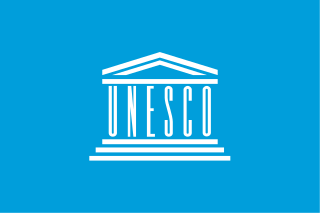
Film preservation, or film restoration, describes a series of ongoing efforts among film historians, archivists, museums, cinematheques, and non-profit organizations to rescue decaying film stock and preserve the images they contain. In the widest sense, preservation assures that a movie will continue to exist in as close to its original form as possible.

International Mother Language Day is a worldwide annual observance held on 21 February to promote awareness of linguistic and cultural diversity and to promote multilingualism. First announced by UNESCO on 17 November 1999, it was formally recognized by the United Nations General Assembly with the adoption of UN resolution 56/262 in 2002.
In library and archival science, digital preservation is a formal process to ensure that digital information of continuing value remains accessible and usable in the long term. It involves planning, resource allocation, and application of preservation methods and technologies, and combines policies, strategies and actions to ensure access to reformatted and "born-digital" content, regardless of the challenges of media failure and technological change. The goal of digital preservation is the accurate rendering of authenticated content over time.

UNESCO's Memory of the World (MoW) Programme is an international initiative launched to safeguard the documentary heritage of humanity against collective amnesia, neglect, decay over time and climatic conditions, as well as deliberate destruction. It calls for the preservation of valuable archival holdings, library collections, and private individual compendia all over the world for posterity, the reconstitution of dispersed or displaced documentary heritage, and increased accessibility to, and dissemination of, these items.

Cultural heritage is the heritage of tangible and intangible heritage assets of a group or society that is inherited from past generations. Not all heritages of past generations are "heritage"; rather, heritage is a product of selection by society.

The Blue Shield, formerly the International Committee of the Blue Shield, is an international organization founded in 1996 to protect the world's cultural heritage from threats such as armed conflict and natural disasters. Originally intended as the "cultural equivalent of the Red Cross", its name derives from the blue shield symbol designed by Jan Zachwatowicz, used to signify cultural sites protected by the 1954 Hague Convention for the Protection of Cultural Property in Armed Conflict.

The National Film and Sound Archive of Australia (NFSA), known as ScreenSound Australia from 1999 to 2004, is Australia's audiovisual archive, responsible for developing, preserving, maintaining, promoting, and providing access to a national collection of film, television, sound, radio, video games, new media, and related documents and artefacts. The collection ranges from works created in the late nineteenth century when the recorded sound and film industries were in their infancy, to those made in the present day.
FFV1 is a lossless intra-frame video coding format. FFV1 is particularly popular for its performance regarding speed and size, compared to other lossless preservation codecs, such as M-JPEG2000.

Ngā Taonga Sound & Vision is an archive that was launched on 31 July 2014, following the completion of a three-year process whereby the New Zealand Film Archive "absorbed" the collections and operations of the RNZ Sound Archives Ngā Taonga Kōrero in 2012 and the Television New Zealand Archive in 2014.
An orphan film photos is a motion picture work that has been abandoned by its owner or copyright holder. The term can also sometimes refer to any film that has suffered neglect.
The Association for Recorded Sound Collections (ARSC) is a nonprofit organization dedicated to the preservation and study of sound recordings. Established in 1966, members include record collectors, discographers, and audio engineers, together with librarians, curators, archivists, and researchers.

The World Heritage Convention, formally the Convention Concerning the Protection of the World Cultural and Natural Heritage, is an international treaty signed on 23 November 1972, which created the World Heritage Sites, with the primary goals of nature conservation and the preservation and security of cultural properties. The convention, a signed document of international agreement, guides the work of the World Heritage Committee. It was developed over a seven-year period (1965–1972).
A cinematheque is an archive of films and film-related objects with an exhibition venue. Similarly to a book library, a cinematheque is responsible for preserving and making available to the public film heritage. Typically, a cinematheque has at least one motion picture theatre, which offers screenings of its collections and other international films.
The Association of Moving Image Archivists (AMIA) is a 501(c)(3) not-for-profit organization established to advance the field of moving image archiving by fostering cooperation among individuals and organizations concerned with the acquisition, description, preservation, exhibition and use of moving image materials.

The United Nations Educational, Scientific, and Cultural Organization is a specialized agency of the United Nations (UN) with the aim of promoting world peace and security through international cooperation in education, arts, sciences and culture. It has 194 member states and 12 associate members, as well as partners in the non-governmental, intergovernmental and private sector. Headquartered in Paris, France, UNESCO has 53 regional field offices and 199 national commissions.

The International Year of Chemistry 2011 was a year-long commemorative event for the achievements of chemistry and its contributions to humankind. The recognition for chemistry was made official by the United Nations in December 2008. Events for the year were coordinated by the International Union of Pure and Applied Chemistry (IUPAC), and by UNESCO, the United Nations Educational, Scientific, and Cultural Organization.

The International Association of Sound and Audiovisual Archives (IASA) was established in 1969 to serve as a forum for international co-operation between archives, libraries, and individuals interested in the preservation of recorded sound and audiovisual documents.
The Association of European Cinematheques is an affiliation of 49 European national and regional film archives founded in 1991. Its role is to safeguard the European film heritage and make these rich audiovisual records collected and preserved by the various film archives accessible to the public. ACE is a regional branch of FIAF Fédération Internationale des Archives du Film / International Federation of Film Archives. ACE members are non-profit institutions committed to the FIAF Code of Ethics.
The Coordinating Council of Audiovisual Archives Associations (CCAAA) is an umbrella group of international private organizations working on audiovisual archiving. These professional organizations have a common goal of promoting and encouraging the preservation and the accessibility of the world's audiovisual heritage. The CCAAA member organisations work with many AV materials including: films, TV, radio, photographs and audio recordings.

The Fédération Internationale des Archives de Télévision - International Federation of Television Archives (FIAT/IFTA) is a worldwide association of institutions, commercial companies and individuals managing or with a special interest in audiovisual archiving in general and television archives in particular. Many members are commercial and public broadcasters, but also national (audiovisual) archives are involved ever more. In general terms the association wants to connect the members, to spread knowledge in the field of television archiving and to defend their interests on an international level.











